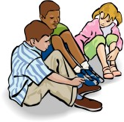 Understanding and accepting death/dying is a trying experience for most adults. Children who experience death for the first time often feel great confusion and fear. Perspectives on the meaning of death and customs for confronting it vastly differ among and within cultures, religions, and individuals. Parents and guardians are encouraged to thoroughly explore their own understanding of death so that they are able to effectively communicate with their children.
Understanding and accepting death/dying is a trying experience for most adults. Children who experience death for the first time often feel great confusion and fear. Perspectives on the meaning of death and customs for confronting it vastly differ among and within cultures, religions, and individuals. Parents and guardians are encouraged to thoroughly explore their own understanding of death so that they are able to effectively communicate with their children.
Unfortunately, the issue of death/dying is one that adults must discuss with children at some point in their lives. Whether it is the expected death of an elderly family member, the accidental death of a peer/relative, or the death of a family pet; children will become aware of death and dying at an early age. Helping children to cope with their sense of loss and to grieve appropriately can be a difficult responsibility.
Children frequently display a variety of reactions to death, including anger or acting-out behavior, a sense of detachment, a need for reassurance, and signs of regression or immaturity. They may appear to be overly distraught and emotional, act as if nothing has happened, or ask repetitive and unusual questions.
As you talk to your children about death and loss, keep in mind a few general guidelines. These include the following: talking to them at age-appropriate levels, listening to their questions and concerns, providing them with nurturing and support, and helping them to engage in activities so that they think about things beyond the loss that they have experienced.
Recommendations
1. Developmental levels play an important role in understanding death. This is crucial for parents to understand so they can recognize the way that their child may conceptualize death. The following list provides some brief insight for understanding these concerns:
– Preschoolers often see death as reversible and temporary.
– Early elementary-school children begin to realize that death is final but may believe that it
will not happen to them.
– Children in late elementary school through adolescence fully understand that death is
irreversible and that they will die some day. This understanding may be the start of religious
and philosophical experiences for them.
2. Answer your children’s questions about death. Do not avoid talking to them when they ask difficult questions to which you may not know the answer. While it is fine for you to not know all the answers about death, life’s greatest uncertainty, it is important for you to reassure your child, letting him or her know that you also think about these things and that you will work with the child to develop his or her own thoughts about death.
3. Answer questions at your child’s level of understanding. If your child asks a complex question, such as what happens after death, then initially provide a simple and straightforward answer. Should the child have further questions that become increasingly complex, then respond with a slightly more complex answer. Be careful not to “talk over the child’s head.”
4. Allow children to grieve. There is no correct way to grieve or any order to the grieving process.
5. Allow yourself to grieve. If the death involves a close family member, then it is appropriate for your children to see your sadness. However, it is also important for you to seek the support of your family and friends and not to use your children to manage your emotional needs.
6. Seek grief counseling for yourself or your children when appropriate. It is important to find a counselor that has expertise and/or experience in this area.
7. There are several movies that confront life and death in a way that is appropriate for children. Films such as The Lion King or Bambi may be helpful for younger children. The popular Harry Potter series might be helpful to slightly older Elementary-school age children, in order for them to understand the death of family members. Adolescents might learn about some of the psychological aspects of death by watching Batman: The Beginning. It is important to not only have children watch these films, but to use them as opportunities for later discussion about how the characters experienced death and the process of moving forward.
8. Engaging in religious and spiritual traditions and practices can be beneficial after the death of a loved one. Families are encouraged to pursue their own paths in this regard, but such rituals often provide structure and foster understanding.
9. Parents and guardians are strongly encouraged to read about children’s understanding of death. Provided below are lists of helpful websites and books that discuss the different ways of addressing children with specific kinds of death/dying.
Websites
Kids Health: Explains developmental issues in discussing death at age-appropriate levels.
NASP Online: Comprehensively discusses the psychological impact of death and loss on children.
Scholastic – Teachers: Common-sense advice for teachers who may need to talk to children about death and loss.
Vet Medicine: Advice for talking to kids about the death of a pet.
Books
Buscaglia, Leo. 1982. The Fall of Freddie the Leaf: A Story of Life for All Ages. Slack: Thorofare, NJ. (A classic book about life and death for younger children.)
Dougy Center Staff. 1999. 35 Ways to Help a Grieving Child (Guidebook Series). Dougy Center: Portland, OR. (Useful for talking to teens and younger children about death.)
Goldman, Linda. 2009. Great Answers to Difficult Questions About Death: What Children Need to Know. Jessica Kingsley: Philadelphia, PA. (Addresses the loss of parents, siblings, and other family members.)
Schaefer, Dan. 2010. How Do We Tell the Children?: A Step-by-Step Guide for Helping Children and Teens Cope When Someone Dies. Newmarket Press: New York, NY. (Helpful for understanding developmental issues, with a chapter about taking children to funerals.)
Receive online class information and helpful tips from Dr. Randy Kulman's LearningWorks for Kids |



